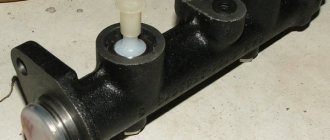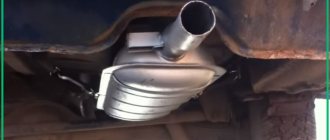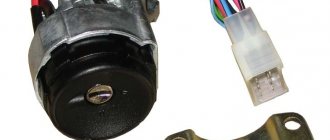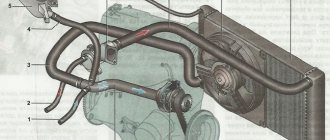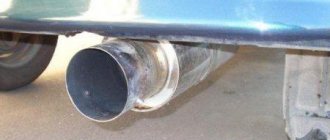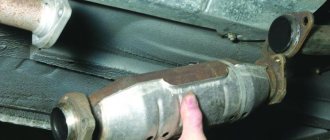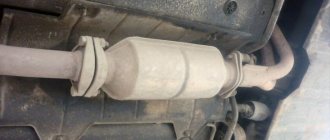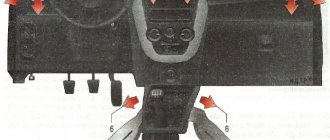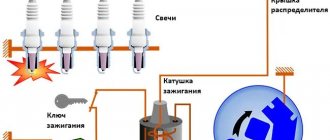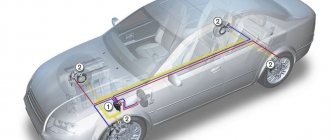Many car enthusiasts do not even realize how important the car exhaust system is in the trouble-free operation of the power unit, and do not pay due attention to its maintenance, as a result of which engine failure may occur. It is for this reason that you should carefully familiarize yourself with the principle of operation of the exhaust system, its design features, and know what the exhaust system consists of.
In the operation of an internal combustion engine, an important role is played by the timely removal of exhaust gases, which begin to accumulate in the combustion chamber of the cylinder head immediately after ignition of the fuel mixture. This task is intended to be performed by exhaust systems, or as car enthusiasts say, mufflers, which are equipped with all modern cars. The proper operation of the exhaust system, aimed at removing the remains of the spent fuel mixture from the engine, entirely depends on the serviceability of all its components, which have some design differences depending on the type of engine.
The principle of operation of the exhaust system
The modern automobile exhaust system consists of several parts, unlike the first devices, which had the form of a mechanical valve, which was forced to be opened manually by the driver of the car. All elements of the exhaust system, which are connected to each other using mounting bolts through flanges located at their ends, are intended for:
- removal of exhaust gases and other unburned fuel mixture residues from the engine combustion chamber;
- reducing the noise emitted by the motor during operation;
- reducing the amount of toxic substances in the vehicle exhaust;
- preventing toxic gases from entering the vehicle interior.
The design of the vehicle exhaust system has a fairly simple principle of operation, which involves removing exhaust gases from the combustion chamber, passing them through pipes to the rear of the vehicle, while reducing, due to the tightness of the entire structure and connections through flanges with heat-resistant seals, the noise emitted by the engine.
Reducing the amount of toxic substances in exhaust gases is achieved through the use of catalytic converters (catalysts) in the design of the exhaust system, the performance of which is monitored by a special sensor called a lambda probe. In modern diesel cars, to improve the environmental friendliness of the exhaust, manufacturers use a particulate filter, which is also equipped with the diesel exhaust system.
In the design of a diesel engine, as well as a modern gasoline unit, a turbocharger is often used, which uses an air mixture of oxygen and exhaust gases taken from the exhaust manifold to supply the combustion chamber. The amount of exhaust gases entering the turbine is regulated by a sensor located on the exhaust manifold housing.
Muffler functions
The muffler is designed to reduce the noise level that occurs during the processing of gases and air and their release into the atmosphere. The second main function of this tool is to convert energy from processed gases, reducing their temperature and reducing their speed.
Several chambers of different sizes, separated by a partition, realize the expansion and contraction of the flow. This happens thanks to the diaphragm hole, also called a throttle.
In addition, the muffler provides for a change in the initial direction of flow of these same processed gases. This is what helps dampen high-frequency sound vibrations.
The design of car mufflers is constantly undergoing changes, although the general principle of operation and the design itself have remained unchanged for many decades. Today this is not an ordinary metal “can” but a full-fledged system that ensures the correct operation of the car engine. That is why, if steam starts coming out of the muffler or popping noises are heard, it is necessary to immediately diagnose and repair this important unit.
Design of the structure and purpose of its components
The parts that make up this design have different functional loads and their own designations, reflecting the stages of their work. The exhaust system diagram itself and the names of its parts look like this:
- exhaust manifold;
- exhaust pipe;
- catalyst or in other words catalytic converter;
- resonator or flame arrester;
- muffler.
The exhaust manifold is an attached type of equipment of the power unit, and is designed to receive exhaust particles and gases of the fuel mixture from the combustion chambers of each cylinder into it, and is made mainly of ceramics, cast iron or stainless steel alloys with increased heat resistance.
Exhaust system design
The downpipe, referred to by car enthusiasts as the “pants” due to its similar appearance, is designed to combine several streams of exhaust gases into one and further transport them to the catalytic converter (catalyst). The pipe is often equipped with a so-called corrugation, which dampens the vibration transmitted to the entire structure of the exhaust system by the running engine.
The catalyst is a ceramic honeycomb, the surface of which is coated with a layer of an alloy of platinum and iridium, which allows exhaust gases to enter into a chemical reaction with them, resulting in their separation into oxygen and nitrogen oxide. The released oxygen in the catalyst helps to burn the remainder of the fuel mixture more efficiently, as a result of which only a nitrogen-dioxide-carbon mixture is supplied to the muffler. The operation of the catalytic converter is monitored by a special lambda probe sensor, transmitting a signal to the control unit of the vehicle's power unit. A similar sensor is installed on the exhaust manifold to analyze the toxicity indicators of the exhaust gases entering the catalyst.
A resonator or flame arrester is designed to reduce the high temperature of exhaust gases, which is achieved using its cellular internal structure. The last detail in the design is the muffler, the task of which is to reduce the noise of a running engine due to a perforated pipe inside its housing.
All components of the exhaust system are connected to each other through flanges using fastening bolts and heat-resistant seals, which are responsible for the tightness of this structure, without which the full operation of the engine of a modern car is impossible.
Exhaust system diagram
A few words about forward flows
I have a separate article about this, read it. But some of us don’t need acoustic comfort – only power is important. Therefore, the resonator, and the muffler itself, are being modernized, the partitions that “stop” the gases are removed - accordingly, energy is not wasted on overcoming these barriers, so you get + 5 + 7% to the engine power.
And if you also remove the catalyst, another + 5%. This way you can achieve up to 10% power, which is already noticeable!
However, such “roaring tuning” is prohibited by law! You can't drive on the streets above certain decibels, only on race tracks. YES, even without a catalyst, you will never pass the car’s maintenance, and therefore will not receive insurance.
Possible malfunctions, methods for eliminating them and tuning options
The design of the exhaust system is an ideal option for tuning a passenger vehicle, thanks to the ease of installation of its components and the presence of a wide range of different parts. The most common option for tuning a muffler is to install a so-called direct-flow exhaust, when the resonator is removed from the system.
The most common malfunctions of the exhaust system are associated with loss of tightness of parts or their connections, the seals in which can be severely worn out. To replace the sealing elements, you need to purchase an exhaust system repair kit, and unscrew the fastening bolts and replace them with new ones.
Exhaust system parts made from various metal alloys are subject to significant heating, sudden temperature changes, and operate under conditions of increased loads, as a result of which they are subject to severe wear and burnout of internal parts. These breakdowns can be determined by the loud noise of a running engine and visual diagnostics of the exhaust system, after which the damaged structural part must either be replaced with a new one in case of internal faults, or its body must be repaired using electric/gas welding.
In modern cars, the operation of the power unit is controlled by a control unit, which receives certain signals from numerous sensors located on all its structural components. The design of the exhaust system contains a sensor called a lambda probe, which measures the amount of toxic substances in the exhaust gases. Only a diagnostic stand can detect its malfunction or incorrect operation, after which the sensor must be replaced.
It is impossible to operate a car with a faulty exhaust system, this can lead to a breakdown of the power unit, coking of the working surface forms on the valves, leading to a loss of engine power, and to possible harm to the health of the driver and all passengers due to toxic substances entering the cabin. exhausts.
If you have any questions, leave them in the comments below the article. We or our visitors will be happy to answer them
Prices
- The cost of manufacturing an exhaust system or individual elements according to an individual project is by agreement
Our specialists are ready to make an exhaust system according to your preferences.
We manufacture exhaust systems for any type of transport.
When working, our specialists use various types of steel, titanium, aluminum
- Exhaust system repair from 1500 rubles
- Exhaust production from 7500 rubles
- Exhaust system tuning from 5,000 rubles
- Replacement of components from 3000 rubles
The price depends on the amount of work, material of manufacture, type of welding or fastening.
Carburetor K-22D
The K-22D carburetor, installed on the GAZ-69 car engine, is a three-diffuser carburetor.
The main dosing system of the carburetor operates on the principle of regulating the vacuum in the diffuser. It consists of a main jet 27, the nozzle of which goes into the small diffuser 10, an additional nozzle 25, the nozzle of which goes into the neck of the large diffuser 14, and an automatic bypass air valve, consisting of four elastic plates 5.
The amount of gasoline passing through the main jet can be adjusted depending on the operating conditions of the engine using needle valve 26.
The idle system consists of an idle jet 6, two air jets 9 and an emulsion jet 5.
The economizer and accelerator pump are combined into one system, consisting of an accelerator pump with a piston 18, a pump discharge valve 17, a jet 15, a check valve 19, a jet 28 and an economizer valve 24. The accelerator pump is driven mechanically by the throttle valve.
The float chamber communicates through tube 18 with the air pipe, and not with the atmosphere, as a result of which the influence of the air filter resistance on the operation of the carburetor is eliminated.
When the engine is running at low idle speed, the throttle valve is closed. Due to the high speed of air movement through the narrow gap between the damper and the walls of the mixing chamber, a vacuum is formed in the throttle valve area.
Since the outlet of the idle system is located in this area, the vacuum is transferred to the system and it operates as an independent carburetor.
Gasoline from the float chamber enters the idle jet 6 through an additional jet 25 through the carburetor channels. Having passed the idle jet, the gasoline rises and, meeting the air entering through the air jet 9, mixes with it and passes through the emulsion jet 8 in the form of an emulsion.
Coming out of the emulsion nozzle, gasoline again meets the air flow passing through the air nozzle and is mixed with it. The emulsion exits through the idle hole behind the throttle valve.
The emulsion consumption and, consequently, the quality of the combustible mixture at idle is adjusted by screw 2.
When the engine is running and at medium loads (the throttle valve is open approximately halfway), the vacuum in the diffusers increases so much that the bulk of gasoline comes out of the nozzles of the main 27 and additional 25 nozzles.
As the air flow passing through the diffuser increases, the plates 5 of the air bypass valve diverge and the air flow passes by the small 10 and medium 7 diffusers, automatically adjusting the vacuum in the small diffuser and, consequently, the composition of the combustible mixture depending on the throttle opening value.
When the engine is running at full load, the throttle valve is fully open. In this case, the piston 18 of the accelerator pump is in the lower position and, pressing the economizer valve 24, opens access to an additional amount of gasoline, which from the float chamber passes through the economizer nozzle 28 to the additional nozzle atomizer.
When the throttle valve is opened sharply, the accelerator pump piston drops sharply and squeezes gasoline out of the cylinder. Check valve 19 closes, and valve 17 of the accelerator pump opens, and gasoline is released in a stream through jet 15 into the neck of large diffuser 14 - the combustible mixture is enriched.
When starting the engine, the combustible mixture is enriched by closing the air damper 12, which has a safety valve 11.
The K-22G carburetor, which is installed on the engines of GAZ-63 and GAZ-51 A cars, is also made according to the design of the K-22D carburetor.
PBS
What happened after the war? Our former allies began to abandon silent weapons. But in the USSR, on the contrary, they worked throughout the war and after it. This is how the legendary PBS-1 appeared. The task of developing the device was set by the military, who could no longer imagine fighting without reconnaissance units equipped with silent weapons in ambush, reconnaissance or at night. The development was undertaken by NII-61 (now TsNIITOCHMASH), which over the course of 5 years from 1950 brought the new device to the required characteristics. The result was, perhaps, the best universal silencer for standard combined arms weapons to this day. AKM and AKMS, equipped with this device, received the index “B” (silent) to their abbreviation. Even now in our army, many “specialists” prefer AKMB.
AKMS with PBS-1
The principle of operation of the PBS and its predecessor is common - the same cameras and shutters, but in larger quantities. A special cartridge with reduced speed, US-1, was also developed. As a result, the AKMB fired at 400 meters with good accuracy, and when it was not needed, the device was simply removed, and the battle could be fought with standard ammunition. None of our competitors have such a device yet.
PBS-1 disassembled
Analogues produced abroad can be called rather “sound moderators”, since the low-pulse 5.56 NATO cartridge remains supersonic, which greatly increases the noise level when firing. These “cans” on the barrel cannot be compared with PBS. Although there are already separate developments for the 300AC pistol or special cartridge, pistol calibers do not provide the necessary lethality, and the 300 caliber, which is generally similar to our US, is niche and cannot compete in versatility with similar characteristics.
Solution for gasoline engines
Kinds
- The honeycomb onto which the catalytic composition is applied can be made of ceramic. Such neutralizers use a thin layer of precious rare metals as a catalyst. This is the most expensive type of exhaust gas neutralization systems.
- A less expensive option is cellular honeycombs, made by soldering from thin metal foil coated with one of the types of the above-mentioned compositions. Such a system is more efficient, because the area of cellular honeycombs is much larger than that of ceramic ones, and therefore, it is capable of processing a larger volume of exhaust gases.
What did the engineers come up with?
Depending on the generation of environmental regulations, the implementation of the gas recirculation system has also changed. At the moment, automakers have come up with the following options:
- high pressure (oxide content in the exhaust 0.25 g/km);
- low pressure (0.18 g/km);
- combined (0.08 g/km).
High pressure exhaust gas recirculation system
This system can be found on diesel engines that comply with Euro 4. Its idea is to divert some of the exhaust gases directly from the exhaust manifold and feed them into the channel before the intake manifold.
This procedure is carried out using a special valve with an electric or pneumatic drive, which allows the required amount of gases to pass through.
Control over this is entrusted to the engine control unit; it calculates the valve opening moments depending on the position of the throttle valve and takes into account the operating mode of the engine.
On some models, the gases are further cooled on their way to the intake manifold.
Low pressure exhaust gas recirculation system
The low pressure version of the exhaust gas recirculation system is more advanced and is installed on vehicles with a diesel engine that meets Euro 5 standards. Its peculiarity is that the selection of fuel combustion products is carried out after the particulate filter.
This allows cooler gases to be supplied to the intake manifold, which, moreover, will not contain excess solid particles.
The system includes various pipes, as well as dampers and valves that regulate the intensity of recirculation. All this is controlled, of course, by the motor electronics.
Combined exhaust gas recirculation system
The cleanest and most modern of the listed three recirculation systems is combined.
Cars that have it on board comply with the strictest environmental standards Euro-6. In principle, it is a combination of the first two options. Most of the time the system operates on the same principle as the low pressure version, but under certain engine conditions the high pressure circuit is connected.
This is how car manufacturers seriously care about the environmental friendliness of their products, and the exhaust gas recirculation system is a perfect example of this.
That's all, see you again on the pages of our blog!
//www.youtube.com/watch?v=K0QAvF2PLsY
Catalyst
This is perhaps the most complex and expensive component in any exhaust system. The body of this element is also made of fire-resistant metal. However, unlike the resonator and the receiving pipe, it is multilayer. Inside this “can” there is a ceramic rod. Additionally, the catalyst is equipped with a wire mesh. It covers the second element of ceramic material.
In addition, the device has a layer of thermal insulation with double walls. Why is the catalyst so expensive? In addition to ceramics, expensive materials are used here - palladium or platinum. It is these components that convert harmful gases into hydrogen and safe vapors. In view of this, the minimum cost of a new neutralizer is 40 thousand rubles.
Four ways of sound cancellation
The operating principle is based on 4 main methods of sound attenuation: sound limitation, its reflection, suppression of sound waves using resonance and absorption.
The limiting type is the simplest in its design: it is made in the form of a tapering pipe placed in a metal tank. This type partially suppresses noise, significantly reduces motor power and is installed on the simplest agricultural equipment.
A mirror change in the direction of the acoustic flow is used in installation on scooters and motorcycles. The oscillations are dampened, due to which the rumble is noticeably reduced. The use of this option is possible only on two-stroke engines, due to low power.
The third option is used on cars. Several partitions are installed inside the resonator, forming cavities, which are in turn connected by hollow steel rods. Here two factors play a role in sound absorption:
- sound waves and vapors change the direction of their movement several times due to mirror partitions;
- the frequency of acoustic vibrations coincides, thanks to precise calculations of the dimensions of the resonant chambers and tubes. The created resonance suppresses rumble and rumble.
Taking into account the variety of engines and their power, each has its own muffler of this type.
The absorbing sample in its design resembles the suppression of noise waves, with the difference that its pipes have numerous holes of different diameters. On the sides of these partitions a heat-resistant material is placed, for example, kaolin or basalt wool, which can withstand temperatures up to 700 degrees Celsius. The acoustic flow dissipates, superimposing its waves on each other after passing through. The remaining part goes into the filler, and the remainder is smoothed out
- exhaust and intake channels;
- housing with sealant;
- perforated tube;
- mate
- partitions and changes in direction.
